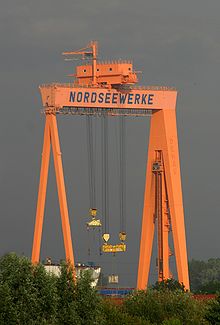Gantry crane



A gantry crane has a door frame ( portal ) like frame , which on a loading area two lanes is positioned mobile. On its upper part, the bridge , the trolley moves back and forth across the main direction of travel.
description
The gantry crane spans its work area like a portal . It usually runs on two parallel rails on which it supports itself with its supports . This differs from a bridge crane that runs on elevated rails. The portal is a steel construction , which is mostly made in half-timbered or frame construction. The crane has a pendulum support and a rigid support to compensate for the temperature-related change in length of the crane bridge (horizontal part of the portal). The trolley with the hoist moves along the crane bridge . However, a slewing rail crane can also be mounted on the crane bridge. The rails can be laid freely or sunk into the ground. The power is usually supplied via a motor or spring cable reel , a conductor line, a trailing cable system or via sliding contacts in the floor. The drive of the portal must cover the same path on both sides to avoid tilting. The wheels should actually be connected by a rigid shaft, but an electric shaft is used. Each wheel is driven by a slip ring motor. The motors have a common rotor circuit, which means that the slip frequencies and the speeds are the same. The two motors act like two synchronous machines that are fed with a variable frequency. The electric shaft has even inherited the tendency to oscillate from the synchronous machine.
Due to their design, portal cranes can lift very large loads between the supports. Since the supports are loaded vertically, the maximum bending stress on the crane bridge and the lifting capacity of the cable hoist are primarily decisive for the maximum possible load. There is also no need for a counterweight if the crane bridge does not protrude over the supports. However, this is often the case with gantry cranes in port facilities, where the rails on the quay wall place very high demands on them, as this support is the most stressed. Depending on the length of the boom, an additional weight may be necessary on the opposite side; this is usually built into the carriage of the support.
The gantry crane can move the load in all three directions.
Application area
Gantry cranes are used in goods handling and storage areas. They are also used in assembly halls , in shipyards and on track construction trains.
Special forms
In the case of semi-portal cranes , one of the rails is elevated, for example on a hall wall. If both sides are elevated, it is not a gantry crane, but a bridge crane .
A gantry crane that is only operated in a stationary manner and whose supports may not be moved under load is called a gantry crane .
Cranes that carry a (luffing) slewing crane on the portal instead of a crane bridge are called portal (luffing) slewing cranes .
Mobile gantry cranes with rubber tires, so-called portal lift trucks , are used to load and transport containers to container storage areas.
Harbor cranes , which are mounted on a small portal, are called gate cranes . Usually there is space under the portal for one or two truck widths or railroad tracks.
Another special form are rubber-tyred gantry cranes , so-called RTG ( rubber-tyred gantry cranes ), which do not require a guide rail . They are used for container handling in container storage areas and drive in alleys over the container stacks and one or more truck lanes. Thanks to the rubber tires, you are able to change the container aisles. They are driven by diesel engines, although there has been a strong trend towards electrification using conductor rails in recent years. One then speaks of E-RTG. E-RTG also use a diesel engine to change lanes.

